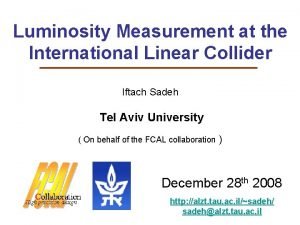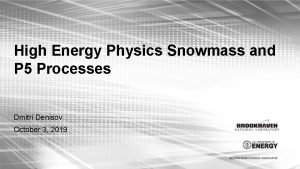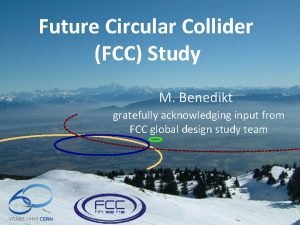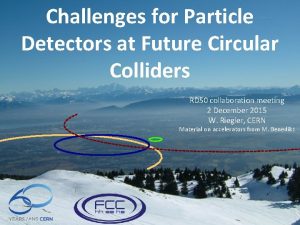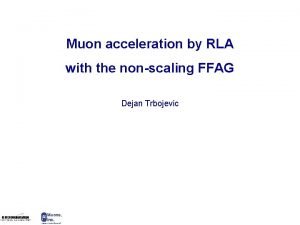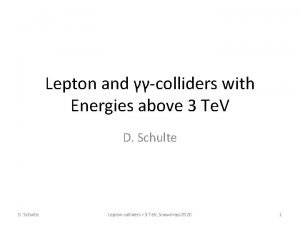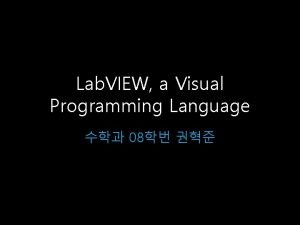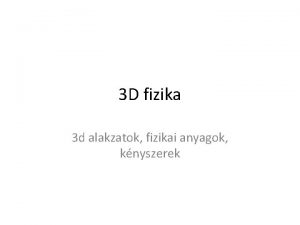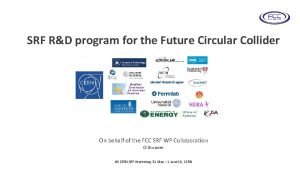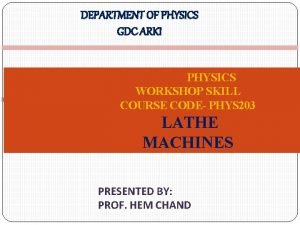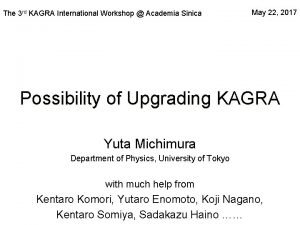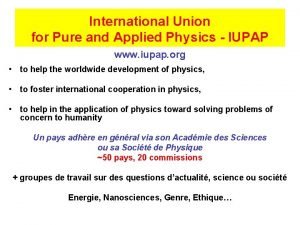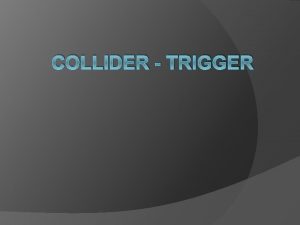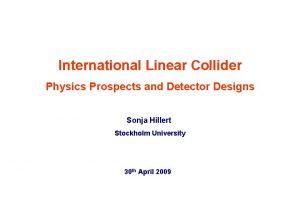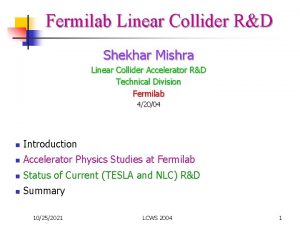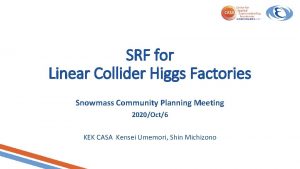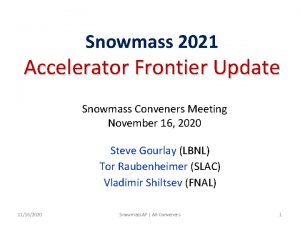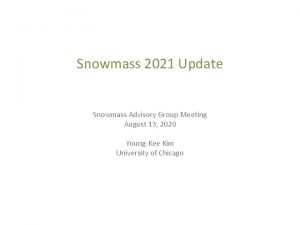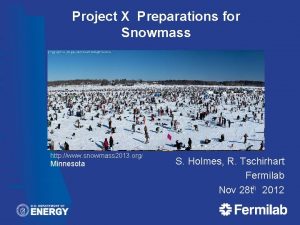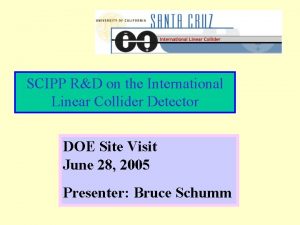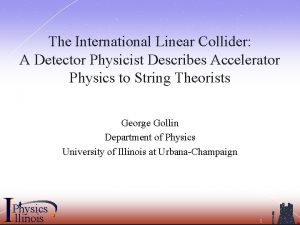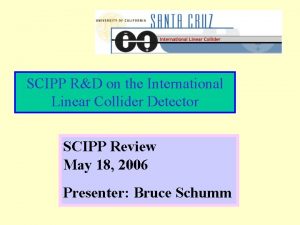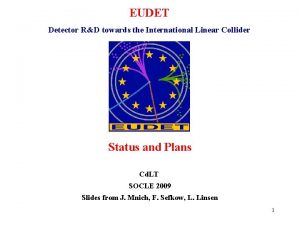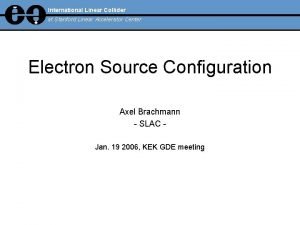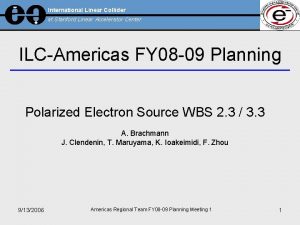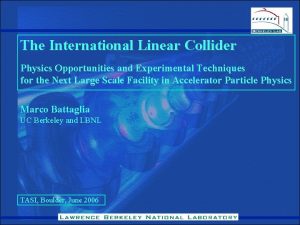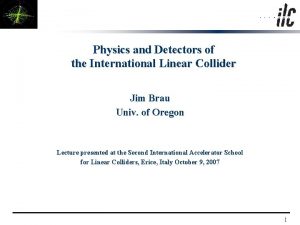International Linear Collider Physics and Detector Workshop Snowmass
















- Slides: 16

International Linear Collider Physics and Detector Workshop Snowmass, Colorado, August 14 -27, 2005 The Optimized Sensor Segmentation for the Very Forward Calorimeter Andrey Elagin JINR Dubna

Beam Calorimeter main parameters ü beam diagnostic ü identification and measurement of the high energy particles Diamond-tungsten Distance from the IP, cm 370 min – max, mrad 4 – 28 Rmin – Rmax , cm 1. 5 – 10 Sensor thickness, mm 0. 5 Absorber thickness, mm 3. 5 Number of layers 30 X 0, mm 4 Rmolier, mm 10 Technologies for the Beam. Cal: 1) Silicon-tungsten or diamond-tungsten sandwich calorimeter 2) Pb. WO 4 crystal

Background from the beamstrahlung Beam. Cal will be hit by beamstrahlung remnants carrying about 20 Te. V of energy per bunch crossing. r- distribution per one bunch Energy deposition in diamond rings per one bunch Severe background for electron identification

Particle identification in the Beam. Cal Motivation The Physics: SUSY particles production ~ 102 fb Signature: + - + missing energy The Background: two photons event ~ 106 fb Signature: + - + missing energy (if electrons are not tagged) Excellent electron identification is needed down to as small angle as possible

Segmentation Optimization Study motivation 4 mm 5 mm Nrings 20 Nrings 16 Ncells 1660 Ncells 1072 Nchannels 49 800 Nchannels 32 160 8 mm 10 mm Nrings 10 Nrings 8 Ncells 430 Ncells 264 Nchannels 12 900 Nchannels 7 920

Particle identification in the Beam. Cal simulation chain Generator: Guinea. Pig for e+e- from ASCII-file beamstrahlung or or ROOT-file “Rndm” for electrons to be • 4 -momentum reconstructed • vertex position GEANT 4 Beam. Cal simulation Summator ROOT-file for hits (G 4 Step) C++ code to sum Edep per cell according to the r- segmentation • side ID • layer ID • X, Y position • energy deposition

Particle identification in the Beam. Cal simulation chain BG sample Summator electrons sample Electron Finder (V. Drugakov) Erec Rrec Since actual parameters (Esim, Rsim) of the electrons are known from the simulation one can extract efficiency of the electron identification from the e. Finer output.

Particle identification in the Beam. Cal Electron Finder from V. Drugakov 1. 2. 3. 4. Use 10 events to define <Ebg> and RMSEbg for each pad. For signal event subtract <Ebg> from Edep for each pad. Keep pads with remaining Edep larger than 5·RMSEbg. Search along each segment: cluster is found if there are more than 7 pads in the segment and more than 4 pads within at least one neighbor segment. BG particle “event”

Particle identification in the Beam. Cal Electron Finder from V. Drugakov 100 Ge. V electron on top of the beamstrahlung Subtraction of average background

Energy reconstruction No background calibration 5 mm intrinsic resolution 23%/ E

Energy reconstruction electrons on top of the background Energy deposited in diamond for 200 Ge. V electrons low BG region ( ~ 0°) 5 mm 10 mm Blue – all events, red – 2·Rmolier from edges

Energy reconstruction electrons on top of the background calibration Low BG region ( ~ 0°) 5 mm resolution 130%/ E

Cuts for reconstructed particles Electrons are considered as reconstructed if: 1. Efit - 3 fit < Erec < Efit + 3 fit 2. Rsim – Cell. Size/2 < Rrec < Rsim + Cell. Size/2 3. sim • Rsim – Cell. Size/2 < rec • Rrec < sim • Rsim + Cell. Size/2 Efit and fit are defined from the distribution of the reconstructed energy for events in the middle of the Beam. Cal

Particle identification efficiency electrons 200 Ge. V Low BG ( ~ 0°) 5 mm 8 mm 10 mm High BG ( ~ 90°) 5 mm 8 mm 10 mm

Inefficiency in particle identification Lost particles for R < 55 mm Inefficiency to identify 200 Ge. V electrons High BG ( ~ 90°) Low BG ( ~ 0°)

Summary • • Complete simulation chain for Beam. Cal exist: – GEANT 4 based simulation (A. Elagin) (crossing angle options are available, implemented by V. Drugakov) – e. Finder for electron identification (V. Drugakov) 5 mm segmentation is the best for electron identification at small radii 8 mm – is not too bad 10 mm segmentation gives 100% efficiency for R > 55 mm
 International linear collider
International linear collider Snowmass process
Snowmass process Fcc collider
Fcc collider Fcc collider
Fcc collider Bnl
Bnl Muon collider
Muon collider Particle collider
Particle collider Unity sphere collider
Unity sphere collider Hadron collider
Hadron collider Hadron collider
Hadron collider Fcc-ee
Fcc-ee Physics workshop skills pdf
Physics workshop skills pdf Kagra international workshop
Kagra international workshop International union of pure and applied physics
International union of pure and applied physics Simple linear regression and multiple regression
Simple linear regression and multiple regression Non linear text
Non linear text Non linear plot
Non linear plot
